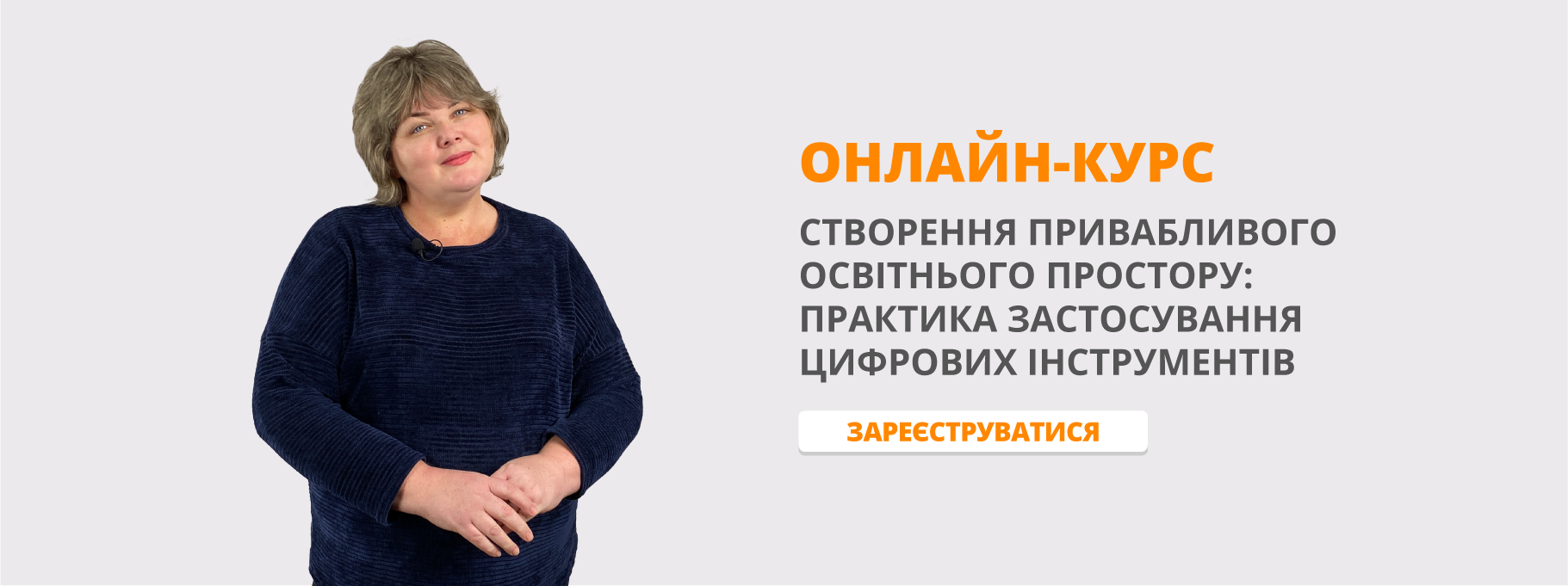Методична розробка заняття States of Matter з дисципліни «Іноземна мова ( за професійним спрямуванням)» спеціальності 133 «Галузеве машинобудування» за освітньо-професійною програ
Лисичанський промислово-технологічний фаховий коледж

States of Matter
методична розробка
з дисципліни «Іноземна мова ( за професійним спрямуванням)»
в закладах фахової передвищої освіти
Розробник:
Скиба Н.М., старший викладач, викладач вищої категорії Лисичанського промислово-технологічного фахового коледжу
2022
ВСТУП
Методична розробка заняття States of Matter виконана у відповідності з методичними рекомендаціями з підготовки та проведення практичних занять у закладах фахової передвищої освіти. Заняття підготовлено відповідно до робочої і навчальної програми з дисципліни «Іноземна мова ( за професійним спрямуванням)» спеціальності 133 «Галузеве машинобудування» за освітньо-професійною програмою «Обслуговування та ремонт обладнання підприємств хімічної та нафтогазопереробної промисловості». У методичній розробці заняття подано розгорнутий план-конспект заняття у формі мовного практикуму з використанням методу критичного мислення, методики роботи з лексичним матеріалом, методу лінгвістичного квесту, рольовою грою, перелік необхідного обладнання, мету і задачі, надано чітку структуру заняття, вдало подано мотивацію пізнавальної діяльності студентів.
Розробка містить багато різноманітних форм та методів роботи (бесіду, читання, мозковий штурм, аудіювання з використанням тематичного відеоролику, групову та парну роботу,), що відповідають індивідуальним особливостям студентів і сприяють успішному досягненню мети заняття.
Методична розробка заняття відповідає теоретичному й методико-практичному розділам навчальної програми, має інноваційний характер, відповідає новітнім технологіям навчання, спрямована на формування комунікативної компетенції майбутніх фахівців, розвиток пам'яті, уваги, сприяють зацікавленості та формуванню комунікативної компетенції майбутніх фахівців.
Методична розробка може бути рекомендована для викладачів іноземної мови в закладах фахової передвищої освіти в якості як основного, так і довідково-дидактичного матеріалу.
МЕТОДИЧНА РОЗРОБКА ЗАНЯТТЯ
Заняття №
Предмет: Іноземна мова
Група:
Тема заняття: States of Matter
Мета: формувати лексичні навички й навички вимови; вдосконалювати навички читання й усного мовлення; розвивати мовну здогадку й мовленнєву реакцію; виховувати зацікавленість у розширенні своїх знань, використовувати раніше вивчені структури, а також збагачувати словарний запас, практикуватися у перекладі речень, розвивати навички логічного викладання думок, пам'ять, виховувати свідоме ставлення до навчання, вчити раціонально використовувати свій час, прищеплювати бажання вивчати іноземну мову.
Обладнання: словники, комп’ютер, роздавальний матеріал
Тип заняття: практичне
Міжпредметні зв'язки: Фізика, Електротехніка, Основи автоматизація технологічних процесів, Аналітична хімія, Загальна хімія, Процеси і апарати
СТРУКТУРА ЗАНЯТТЯ:
1.Організаційний момент:
1)Привітання
2) Перекличка
3)Перевірка готовності до заняття
2. Мотивація навчальної та пізнавальної діяльності студентів, оголошення теми та цілей заняття.
3.Реалізація теми за планом
4. Підсумок заняття. Оцінювання
5. Домашнє завдання
ХІД ЗАНЯТТЯ:
- Find out the words in the dictionary. Write them down and learn.


II. Read the text States of Matter. Use a dictionary, if necessary
All substances can, under the right conditions, exist as a solid, liquid, or gas. These are the three basic physical states (or phases) of matter.
Solids possess the property called cohesion; that is, their component particles (atoms or molecules) are held together by attractive forces. As a result, solid substances are rigid and retain their shape unless deformed by external forces.
There are two principal types of solids: crystalline and amorphous. Crystalline solids have definite crystalline structures. Most also melt at specific temperatures to become liquids. Examples include metals, ice, and many plastics, in addition to obviously crystalline substances such as common salt and diamond. In contrast to crystalline solids, amorphous solids have neither crystalline structures nor specific melting points. Glass is an example of amorphous solids.
Liquids represent the intermediate stage between solid and gas. A liquid’s atoms or molecules have some degree of cohesion and so tend to remain together. But they are not rigidly linked and can therefore move in relation to each other – which is not possible in solids. For this reason liquids flow and in a gravitational field take on the shape of the vessels in which they are contained.
In a gas the constituent particles have negligible cohesion and can therefore move almost completely independently of each other. Like liquids, gasses flow and assume the shape of their containers. Unlike liquids, however, gasses always fill the entire space in their containers – and the container needs to be closed if the gas is not to escape.
The attractive forces between atoms or molecules in a solid are balanced by repulsive forces. As two of these particles approach each other, the outer electrons of one repel the outer electrons of the other, and the atoms or molecules move apart. But because of the attractive forces between them, they move back toward each other again. The overall result of the attractive and repulsive forces is to cause each of the atoms or molecules in a solid to vibrate continually about the same position in a lattice.
The atoms or molecules of a liquid are also affected by attractive and repulsive forces. But a liquid is hotter than the same substance in solid form and its vibrating particles therefore have greater kinetic energy – that is, they vibrate more violently. As a result, the attractive forces cannot hold them in a lattice, and they are relatively free to move.
In a gas the atoms or molecules have so much energy that they have largely broken free of the influences of the attractive and repulsive forces and, therefore, have almost complete freedom of movement.
III. Translate the words of the same root. Define parts of speech.
- to exist – existence – existent
- obvious – obviously – obviousness
- molecule – molecular – intermolecular
- to attract – attraction – attractive
- violent – violently
- to move – movement
- atom – atomic – interatomic
- to shape – shape – shapeless – shapelessness
- relativity – relative – relatively
- to add – addition
- definite – definitely – indefinitely
- to form – formation – deformation
- complete – completely – completeness
- to assume – assumption
- to depend – dependence – dependent – independent – independently
- to contain – container
- entire – entirely
- to specify – specific – specifically – unspecified
- possible – impossible
IV. Find English equivalents to the following expressions in the text.
- мати властивість
- зберігати форму
- два основних види твердих тіл
- кристалічні тверді тіла
- певні точки плавлення
- на відміну від
- ступінь зв'язності
- не пов'язані жорстко
- рухатися щодо один одного
- рідинa
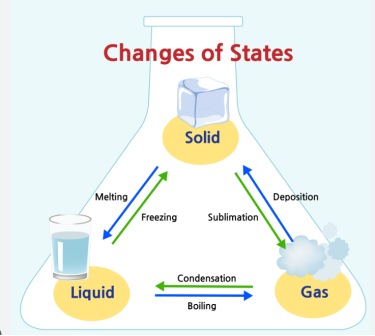
V. Translate the following word combinations and noun groups into Ukrainian
- under the right conditions _______________________________________
- deformed by external forces _____________________________________
- are held together by attractive forces ______________________________
- as a result ___________________________________________________
- to melt at specific temperatures __________________________________
- the intermediate stage between solid and gas _______________________
- degree of cohesion ____________________________________________
- tend to remain together ________________________________________
- therefore ____________________________________________________
- however ____________________________________________________
- the shape of the vessel _________________________________________
- complete freedom of movement _________________________________
VI. Fill in the missing words.
- All substances can ___ as a solid, liquid or gas.
- Solids possess the ___ called cohesion.
- In solids the component particles are held together by ___ forces.
- Crystalline solids have ___ ___ structures.
- Most solids ___ at specific temperatures to become liquids.
- Amorphous solids have neither crystalline structures nor ___ ___ points.
- In a gas the constituent particles have ___ cohesion.
- Like liquids, gasses flow and ___ the shape of their containers.
VII. Practice with someone asking and answering.
- In what forms can all single substances exist?
- What main property do solids possess?
- What do we mean by cohesion?
- What are two principal types of solids?
- Crystalline solids have definite crystalline structures, don’t they?
- Do they melt at specific temperatures?
- What are the examples of crystalline solids?
- Do amorphous solids have crystalline structures and specific melting points?
- What are the examples of amorphous structures?
- Liquids represent the intermediate stage between solid and gas, don’t they?
- What are the properties of liquids?
- Why do liquids flow?
- Do the constituent particles in a gas have any cohesion?
- Do gases behave like liquids? Are gases similar to liquids?
- Are the attractive forces between atoms or molecules in a solid balanced by other forces?
- What is the overall result of the attractive and repulsive forces in a solid?
- Are the atoms or molecules of a liquid also affected by attractive and repulsive forces?
- Why are the atoms or molecules in a gas free of the influences of the attractive and repulsive forces?
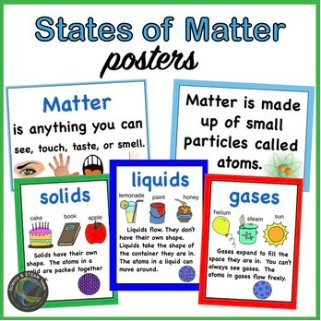
VIII. Color the molecules with the correct color for each state of matter: gases - red, liquid- blue, solid - green
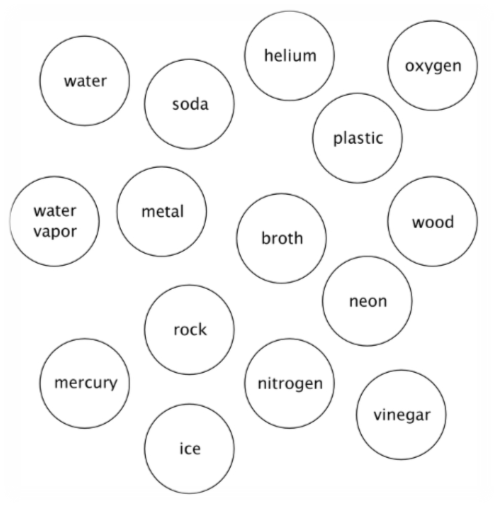
IX. Use the words in the box below to complete each sentence
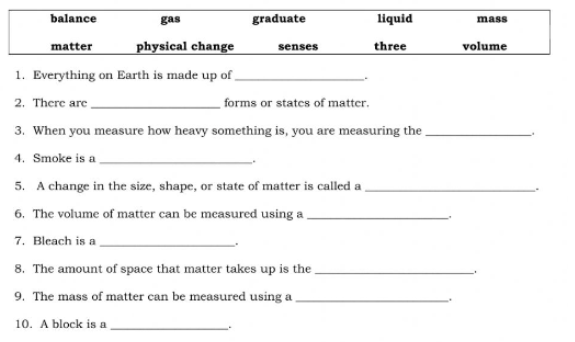
4. Summarizing. Підведення підсумків уроку. Бесіда в режимі T-P1-P2.
T: What topic did we start discussing today? What did we read about? What new words and word combinations have you learned? What material was difficult/ interesting/boring? So, you all see where you need more practice and what you can do well.
5. Setting homework. Постановка домашнього завдання
T: Your home task is to do States of Matter Worksheet. Use your notes from class!
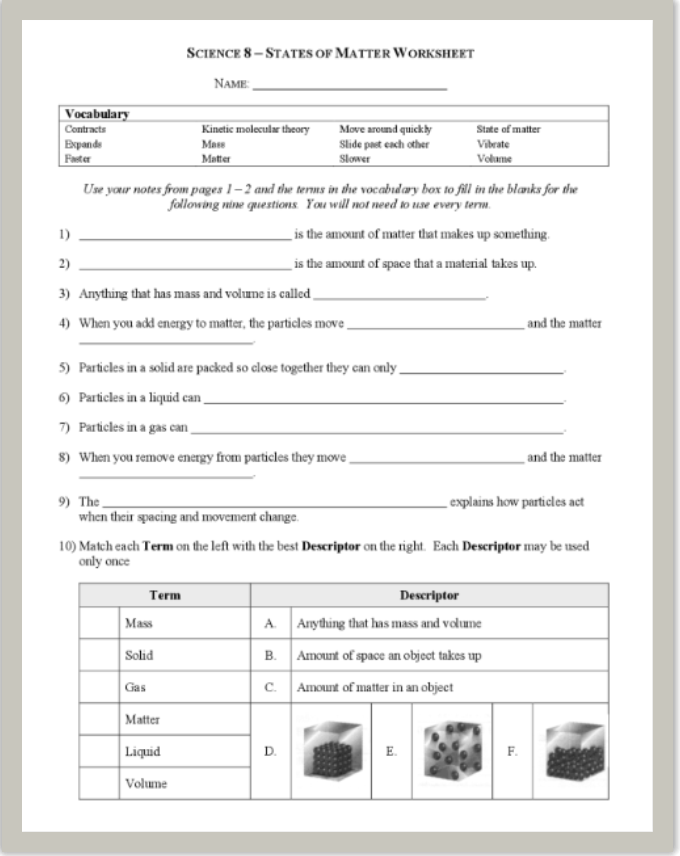
1


про публікацію авторської розробки
Додати розробку
